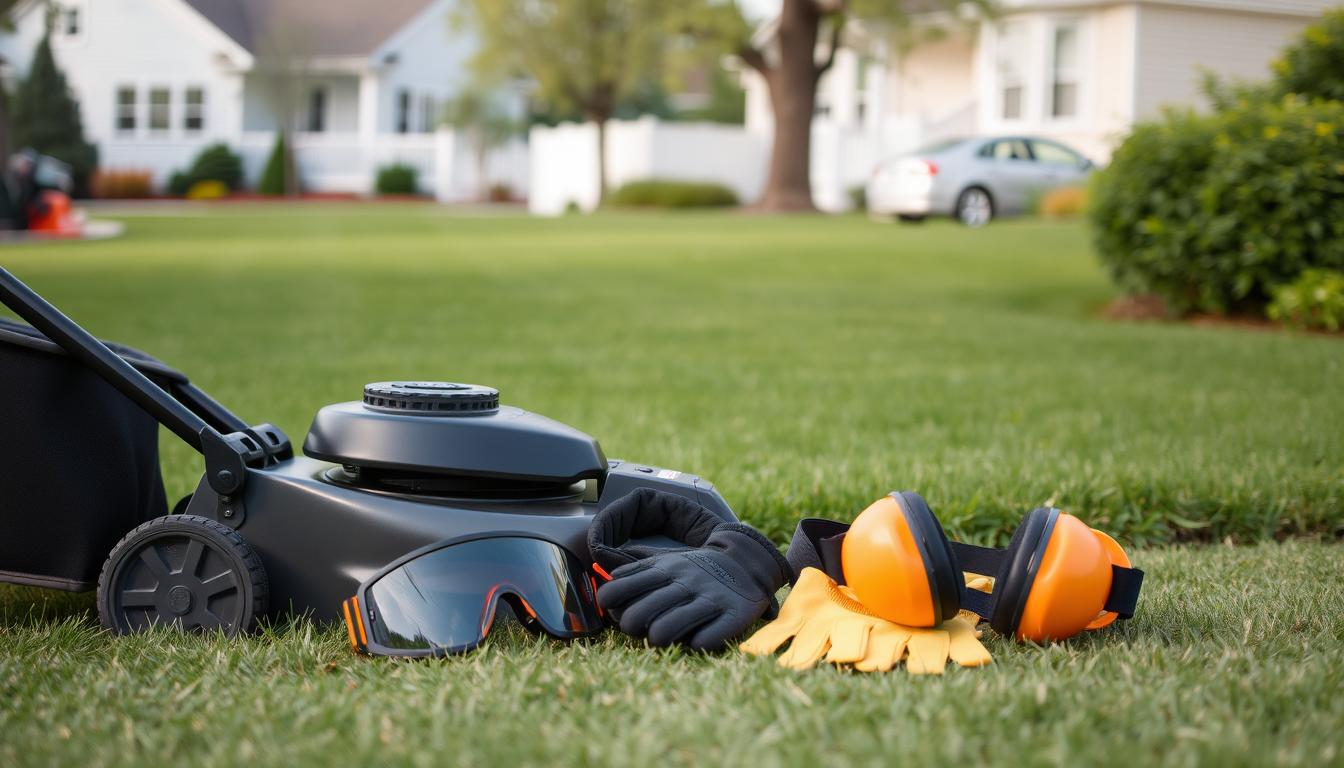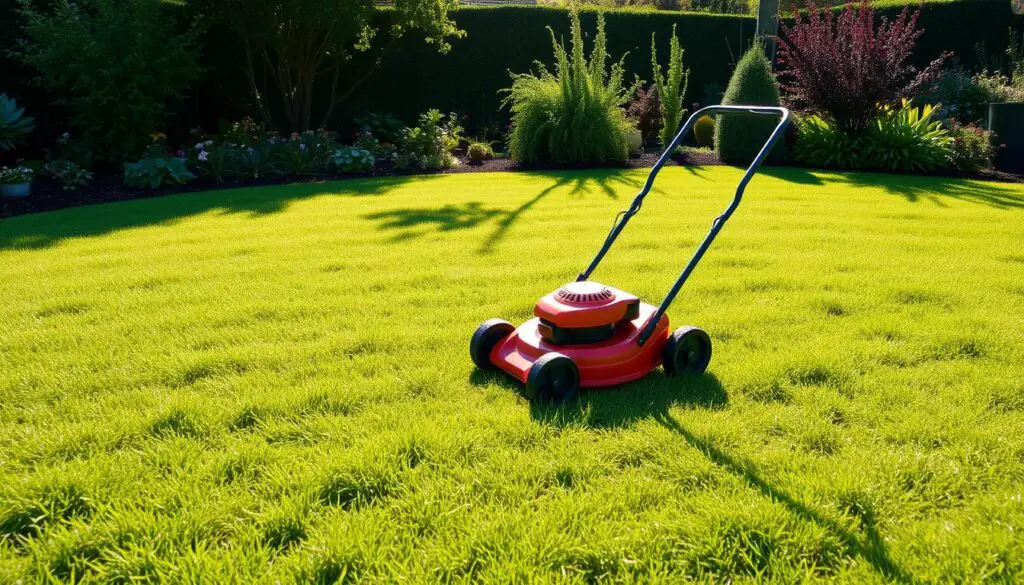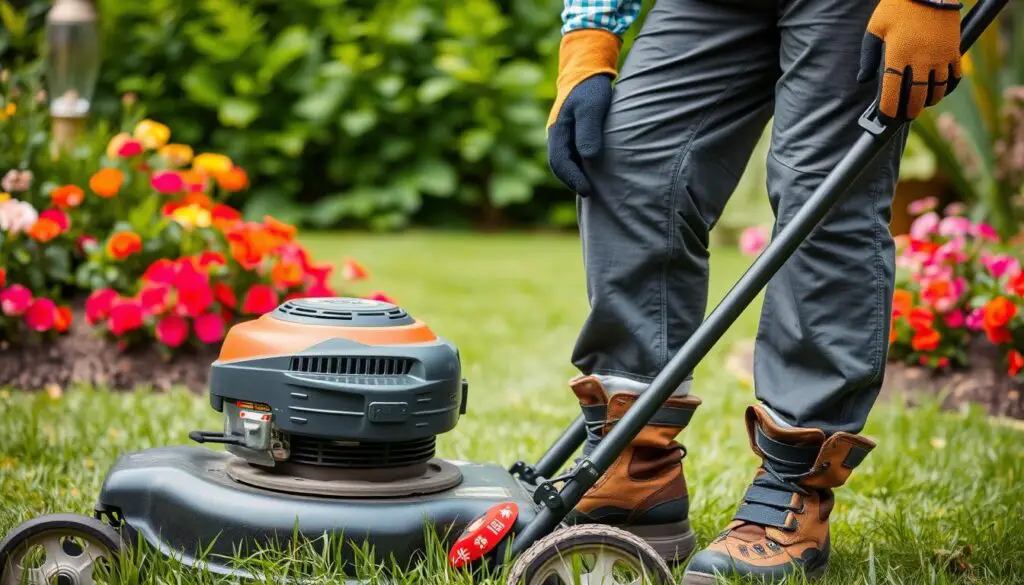Lawn Mower Safety Tips for Beginners

More than 253,000 people were treated for lawn mower-related injuries in the U.S. in 2017. This is a shocking number that shows how important proper lawn mower safety is. Lawn mowers are powerful and can cause serious harm if not used carefully.
They can lead to deep cuts, amputations, burns, and broken bones. The energy from a lawn mower blade is like being shot in the hand with a .357 Magnum pistol. The blades can also fling debris at speeds of up to 100 miles per hour. To stay safe and protect your loved ones, it’s key to follow the right safety steps when using a lawn mower.
Key Takeaways
- Lawn mowers can cause severe injuries, including deep cuts, amputations, and broken bones.
- Hundreds of thousands of individuals are injured by lawn mowers each year in the U.S.
- Wearing proper protective gear, such as sturdy shoes and eye/hearing protection, is essential.
- Always keep children a safe distance away from the mower and never allow them to operate it.
- Inspect the lawn for debris before mowing and avoid mowing on slopes or wet grass.
Wear Proper Footwear
When you’re mowing the lawn, the right shoes are key to staying safe. Don’t wear sandals or flip-flops. They don’t give you enough stability or grip, which raises the chance of slipping and falling.
These shoes are not stable and don’t grip well. This makes it easy to lose your balance and possibly hit the mower’s moving or hot parts.
So, choose sturdy shoes or boots with good grip instead. Shoes with a non-slip sole and closed toes are best. They help you stay steady on your lawn. Look for shoes or boots that support your ankles and have thick, tough soles. This protects your feet from any ground debris or objects.
- Wear proper footwear with good traction to prevent slips and falls
- Avoid sandals, flip-flops, and other open-toe shoes that offer less stability
- Choose sturdy, closed-toe shoes or boots with a non-slip sole
- Ensure your footwear provides enough ankle support and has a thick, durable sole
Wearing the right shoes is a simple but important safety step for lawn mowing. It helps you keep your balance and focus on the job. You won’t have to worry as much about slipping or falling.
Keep Children Away from Lawn Mowers
Keeping children away from lawn mowers is very important. Lawn mowers can be dangerous, and accidents involving children are too common. The American Academy of Pediatrics says kids should be at least 12 to use walk-behind mowers safely. They should be 16 to use ride-on mowers safely.
Never let kids ride on lawn mowers or garden tractors. The risk of them falling off or getting hurt by the blades is too high. Keep them indoors or at a safe distance while you mow the lawn. Debris like rocks and sticks can be thrown by the mower at high speeds, putting kids at risk.
If the mower hits something, stop and check it for damage before using it again. Be careful when mowing on slopes to avoid slipping or tipping over. When using a walk-behind mower, mow across slopes to avoid slipping into the blades. With a riding mower, mow up and down slopes to prevent tipping over.
Lawn mower safety is about protecting everyone, not just you. By following these rules and teaching your kids about safety, you can prevent serious injuries and accidents.

“Each year, both children and adults are injured using riding mowers and walk-behind or hand-powered mowers.”
To keep your family safe, always keep children away from lawn mowers. By following age restrictions and safety guidelines, you can prevent accidents and protect your loved ones.
Clear the Area of Debris
Before you start mowing, make sure to check the area for any debris. Look for rocks, sticks, toys, or other objects that could fly off when hit by the mower blades. These can travel fast and cause serious harm or damage. It’s key to clear the lawn of debris to avoid accidents and keep everyone safe.
The U.S. Consumer Product Safety Commission (CPSC) says about 80,000 people go to the emergency room each year for lawn mower injuries. Over 9,000 of these involve serious harm to kids. Lawn debris can be thrown at high speeds, leading to eye injuries and more.
Inspect the Lawn Thoroughly
Take a close look at your lawn before you start mowing. Search for items that could become dangerous projectiles:
- Rocks
- Sticks
- Toys
- Other objects
Getting rid of these dangerous projectiles makes mowing safer and more enjoyable.
| Potential Hazard | Recommendation |
|---|---|
| Rocks | Remove all visible rocks from the lawn. |
| Sticks | Carefully pick up and discard any sticks or branches. |
| Toys | Collect and move any toys or other objects to a safe location. |
| Other objects | Thoroughly inspect the lawn for any other potentially dangerous projectiles and remove them. |
By clearing the area of debris, you greatly lower the chance of accidents and injuries while mowing. Always put safety first when using a lawn mower.
Avoid Mowing Gravel Areas
When mowing your lawn, pay close attention to the terrain. Avoid mowing gravel paths, driveways, or roads. The mower’s blades can throw rocks and debris, damaging property or hurting people.
On properties with gravel, don’t mow over it. Use a push mower or trimmer to cut grass near gravel. This way, you avoid mowing over gravel itself.
Mowing over gravel can be dangerous. It can break windows, damage siding, or hit passing cars. Always mow near gravel when no one is around. This keeps your property safe and people safe too.
| Potential Risks of Mowing Over Gravel | Recommended Precautions |
|---|---|
|
|
By following these tips, you can mow your lawn safely. You’ll protect your property and others from harm caused by launching rocks and damaging property.
Don’t Pull the Mower Backward
When using your lawn mower, always push it forward. Don’t pull it backward. This helps avoid slipping and falling, which could lead to the mower falling on you. Such incidents can cause serious injuries.
Every year, over 9,000 kids end up in the emergency room because of lawn mower injuries in the U.S. Most of these happen to kids aged 3 to 5 in their own yards. Lawn mower blades can spin at 3,000 rpm, leading to severe burns, punctures, and even amputations.
Maintain Control and Stability
Pushing the mower forward gives you better control and stability. This reduces the risk of slipping or falling. Kids under 12 should not use push mowers, and those under 16 should avoid riding mowers. Keep kids away from the mowing area to prevent accidents.
Lawn mower accidents can cause deep cuts, broken bones, and other serious injuries. Always wear sturdy shoes, long pants, and protective gear like eyewear and hearing protection. And never mow while under the influence of alcohol. Safety should always be your first concern when mowing your lawn.

“It’s always best to push the mower forward, rather than pulling it backward. Pulling it toward you increases the risk of slipping and falling, which could lead to the mower falling on top of you – and that’s a situation you want to avoid at all costs.”
| Injury Statistic | Data Point |
|---|---|
| Children Treated in ER for Lawn Mower Injuries | More than 9,000 per year |
| Typical Age of Children Injured | 3-5 years old |
| Lawn Mower Blade Speed | 3,000 rpm |
| Recommended Minimum Age for Push Mower | 12 years old |
| Recommended Minimum Age for Riding Mower | 16 years old |
Remove the Spark Plug Before Maintenance
Before I start any maintenance or inspection on my lawn mower’s blades, I always remove the spark plug. This step is key to avoid accidental blade movement. Such movement could cause serious injury if the piston starts moving unexpectedly. Disconnecting the spark plug is a simple yet crucial safety measure when inspecting or working on the mower’s blades.
Prioritize Safety First
Every year, over 60,000 people end up in emergency rooms after lawn mowing injuries. That’s why removing the spark plug is a must before inspecting blades or working on blades. This action helps prevent blade movement and keeps me safe from injury.
“Disconnecting the spark plug wire before cleaning or inspecting a gasoline-powered mower can prevent up to 90% of accidental engine starts according to industry data.”
By making spark plug removal a routine before maintenance, I keep my lawn mower safe. This reduces the risk of an unexpected start that could harm me. Lawn mower safety is key for a safe and enjoyable mowing experience.
Regularly removing the spark plug is a simple yet vital step in lawn mower maintenance. It’s a small effort that greatly increases safety for me and my family during lawn care.
lawn mower safety on Slopes
Mowing on slopes needs extra care and the right techniques to stay in control. Whether you’re using a push mower or a riding mower, knowing how to mow on slopes safely is key to avoiding accidents and injuries.
Push Mowers on Slopes
When using a push mower on a slope, mow across it, not up and down. This keeps you from being pulled towards or away from the slope, which can cause loss of control. Move slowly and carefully to avoid slipping or falling.
Riding Mowers on Slopes
For riding mowers, mow up and down the slope, not across. This keeps the mower stable and lowers the risk of tipping. Don’t make sudden speed or direction changes, and watch out for uneven ground that could make the mower roll over.
It’s important to avoid mowing on wet or slippery slopes. The lack of traction makes it harder to control the mower, raising the risk of accidents.
“Always check the manufacturer’s recommendations for the maximum safe slope angle for your specific mower model. Exceeding those limits can lead to a dangerous situation.”
By following these simple tips and staying within your mower’s limits, you can safely tackle the challenges of mowing on slopes. You’ll have a beautiful lawn without any trouble.

Wear Protective Gear
When you’re using a lawn mower, keeping yourself safe is key. It’s important to wear the right protective gear. This includes eye protection, hearing protection, sturdy shoes, and long pants.
Eye and Hearing Protection
Wear safety glasses or goggles to protect your eyes from debris. Eye injuries are common with lawn mowers. Also, the loud noise can harm your hearing. Use earplugs or earmuffs to keep your ears safe.
Sturdy Shoes and Long Pants
Wearing the right shoes is important when mowing. Don’t wear sandals or flip-flops because they’re not stable. Instead, choose sturdy shoes or boots for better grip. Also, wear long pants to protect your legs from debris.
Wearing the right protective gear can greatly reduce lawn mower risks. Always put your safety first when taking care of your outdoor space.

“Continuous exposure to noise levels of 85 decibels or greater can cause hearing loss.”
| Noise Level | Safe Exposure Time |
|---|---|
| 90 dB | 8 hours per day |
| 95 dB | 4 hours per day |
Stay Clear of Moving Blades
When using a lawn mower, it’s vital to stay away from the moving blades. Trying to unclog the chute or adjust the wheel height while the blades are spinning can cause serious harm. Never turn off the kill switch or disable safety features, as they protect you.
Over 274,000 Americans were treated for lawn mower injuries last year. Lawn mower blades can reach speeds of 200 miles per hour, posing a risk for amputations and deep cuts. Debris like rocks and sticks can also cause severe injuries when hit by the blades.
- Never touch the blades while the mower is running.
- Avoid disabling any safety features on your lawn mower.
- Inspect the area thoroughly before mowing to remove potential hazards.
Always put safety first when using a lawn mower. By keeping away from the blades and keeping safety features intact, you can have a safe and easy mowing experience.
“Lawn mower injuries can result in broken bones and even amputations for both adults and children.”
It’s important to be careful and watchful when using a lawn mower. By following these simple safety tips, you can avoid serious accidents and have a safe and enjoyable time mowing your lawn.
Maintain Your Lawn Mower
Keeping your lawn mower in good shape is key for safety and longevity. Before you start, do a detailed check. Look at the safety features and parts closely. Make sure the blade is sharp, the fuel system is good, and moving parts are okay.
It’s smart to get your mower serviced at the start of each season. This means changing the oil, swapping the air filter, and doing other tasks from the owner’s manual. Following the maker’s schedule helps avoid problems and keeps your mower working well all season.
Looking after your lawn mower is crucial for safety and keeping it running long. Regular checks, sharp blades, and maintenance help a lot. By caring for your mower, you’ll have a safer and more fun lawn-mowing time for many years.
FAQ
What are the key safety tips for using a lawn mower?
What type of footwear should I wear when mowing the lawn?
Can children operate lawn mowers?
What should I do to prepare the lawn before mowing?
Can I mow over gravel areas?
Should I pull the lawn mower backward?
What should I do before performing maintenance on the lawn mower blades?
How should I mow on slopes?
What protective gear should I wear when operating a lawn mower?
What should I avoid when operating a lawn mower?
How do I properly maintain my lawn mower?
Source Links
- https://orthoinfo.aaos.org/en/staying-healthy/lawn-mower-safety/
- https://www.assh.org/handcare/safety/lawn-mower
- https://www.richardsonsaw.com/rslm/kind-safety-gear-wear-using-lawn-equipment/
- https://www.gardengatemagazine.com/review/proper-safety-gear-when-mowing/
- https://www.healthychildren.org/English/safety-prevention/at-home/Pages/Lawnmower-Safety.aspx
- https://www.saintlukeskc.org/health-library/lawn-mower-safety-kids
- https://caromonthealth.org/news/mower-safety-101-avoiding-traumatic-injury/
- https://crescentavenue.com/3-lawn-mower-safety-tips-need-follow/
- https://safepaw.com/lawn-mower-safety-protecting-yourself-and-others/
- https://theropshop.com/rugged-u/blog/11-mowing-safety-tips-to-help-you-avoid-disasters
- https://m3ins.com/lawn-mower-safety-school-grounds-crew/
- https://usipwa.us/content-library/lawn-mower-safety/
- https://blog.cincinnatichildrens.org/safety-and-prevention/lawn-mower-safety-psa/
- https://www.safety.af.mil/News/Article-Display/Article/3365980/prioritize-lawnmower-safety-as-spring-approaches/
- https://kempkerstruevalue.com/guide-to-lawn-mower-safety-and-maintenance/
- https://www.k-state.edu/today/announcement/?id=1272
- https://www.briggsandstratton.com/eu/en_gb/support/faqs/browse/servicing-the-spark-plug.html
- https://www.greenindustrypros.com/mowing-maintenance/mowing/article/12096598/how-to-safely-use-standon-mowers-on-slopes
- https://blog.cinfin.com/2020/07/14/safety-tips-riding-mowers-slopes/
- https://www.tdi.texas.gov/tips/safety/lawnmower.html
- https://news.vt.edu/articles/2024/05/yard_lawn_equipment_safety_expert.html
- https://www.bcforestsafe.org/wp-content/uploads/2023/08/mag_CrewTalk-LawnMowerSafety.pdf
- https://www.mikelovelawfirm.com/blog/2016/08/17/must-know-facts-lawn-mower-safety
- https://npip.org/content-library/lawn-mower-safety/
- https://www.terra-lawn-care.com/lawn-mower-safety/
- https://gardeningsolutions.ifas.ufl.edu/care/tools-and-equipment/lawn-mower-care-and-safety/
- https://www.aces.edu/blog/topics/lawn-garden-urban/the-10-steps-of-lawn-mower-maintenance/

